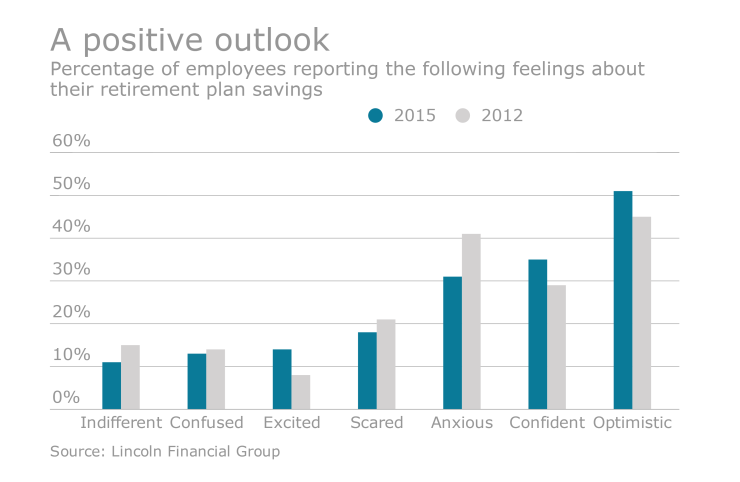They span all ages and income levels, focus on the moment and tend to make snap decisions, then move on quickly. They rarely reflect on their investment or savings decisions, or monitor the progress of their accounts. They now make up the largest group of savers within today’s employer-sponsored retirement plans, and subsequently, may need the most help setting and achieving their retirement goals. Who are they? Meet the Adventurers.
A

This group admits they could be doing a much better job preparing for retirement, and very few of them feel confident in their ability to reach their savings goals. Less than half know their retirement account balance, and only a third exceed their company match. What’s most alarming is they aren’t seeking help. Just 20% work with a financial professional – an action that has proven to lead to savings success over time among retirement savers.
Now that we know who they are, how can today’s employers offer a workplace benefit that can help them? With defined benefit pensions becoming prehistoric, today’s employer-sponsored retirement plans, like a 401(k) or 403(b), are one of the best ways savers have to prepare for their future. While this workplace benefit is one of the most valuable offerings in a workplace benefits package, it can be difficult to instill a “save today, for tomorrow” mentality among employees, and to get and keep them engaged in their plans.
As employers structure a workplace retirement plan that will reach the rising number of Adventurers in their ranks, there are strategies to consider that can better equip employees of all profiles with the tools they need to succeed.
1. Optimize plan design. Retirement plans are not one-size-fits-all, and should be customized depending on workforce composition and demographics. Knowing who your plan participants are is the first step in structuring a plan that will help them to succeed.
While Adventurers may be engaged in their plans at the time of enrollment, this could drop off significantly down the road. Providing consistent points of contact with Adventurers through various channels as well as through plan design elements is a great way to encourage ongoing engagement. Plan components like automatic features and matching contribution strategies can help set savers on a course to success and reduce a lot of the leg work. These options tend to work well among less engaged employees or those who have trouble coming to decisions on their own.
However, it’s important to help Adventurers remember auto features don’t mean they can “set it and forget it.” For example, offering a matching strategy that incentivizes increases can help Adventurers build their coffers faster. Instead of matching 100% of an employee’s 3% deferral, consider matching 50% up to a higher deferral rate, like 6% – ultimately motivating participants to save at a higher level. Automatic enrollment, annual escalation and Qualified Default Investment Alternatives (QDIAs) can also be successful plan components to help drive higher participation and deferral rates.
"66% of participants agree that one-on-one meetings are the most effective communications channel when it comes to making decisions in their retirement plan."
2. Make it personal. Providing savers with access to one-on-one support with financial professionals can be one of the most effective ways to help motivate positive changes in their retirement plans. Lincoln’s research shows that 66% of participants agree that one-on-one meetings are the most effective communications channel when it comes to making decisions in their retirement plan.
In-person guidance can be a great way to relay information and incite change. Also, consider incorporating outcomes-focused conversations with participants. Messages that appeal to participants on a more personal level can help increase overall plan engagement and interest in the retirement benefit. Encourage participants to think about retirement in terms they can relate to and provide examples to help them make personal connections to their progress. This means taking the conversation away from how retirement plans work to engaging participants in discussions about their personal savings behaviors, strategies and goals.
3. Integrate education and communication. Using a variety of media and communication channels to connect with a diverse employee population can have a high impact and help reach employees in a more meaningful way. Evaluate your plan communications strategies annually, and determine if messages or channels need to be changed based on past successes or challenges.
Incorporate mobile technologies and web-based retirement education alongside printed materials, so participants have access to content all day every day. But remember that when using these platforms as part of your overall communications program, content needs to remain fresh and updated to maintain engagement and relevance. An education and communications program that promotes financial wellness by helping employees balance current financial demands with long-term savings needs will help not only Adventurers, but all participants, to succeed over time.
Individual savings behaviors can be deeply engrained and difficult to change. But by understanding your workforce and staying in tune with their shifting behavior patterns and perspectives on retirement, you’ll be well-equipped to structure a plan that can help even the most adventurous of savers reach the highest peak in their lives – retirement savings success.





